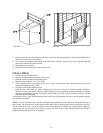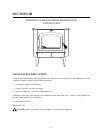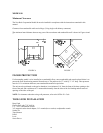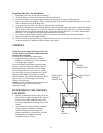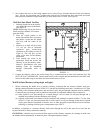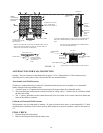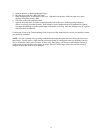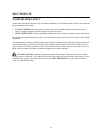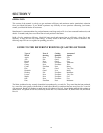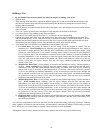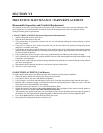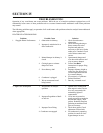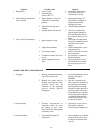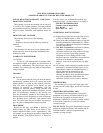
Building a Fire:
1. By-pass damper must be open (pulled out) when starting fire or adding wood to fire.
2. Open the door.
3. While looking inside the firebox, operate the damper bypass door in and out observing the movement. If the
door does not operate freely and seal to the door opening, then the door has jumped out of its track during
shipping and/or installation.
4. Open the primary air control located on each side of the hearth. Also, open shotgun air control located in front
center of hearth.
5. Twist 4 or 5 pieces of non-colored newspaper in a roll and place on the floor of the firebox.
6. Lay several pieces of dry kindling on top of the newspaper.
7. Place three or four small pieces of firewood, 2-3" in diameter, on top of the kindling.
8. Light the newspaper in the front, close and latch the door. Don’t leave the fire unattended at this point. The
draft should start quickly. If not, it may be necessary to preheat the chimney to get the draft started. To do this,
open the door and add newspaper to the top rear of the wood. Light or let this paper ignite and allow to burn
while holding the door slightly cracked. Once the draft has started, close and lock the door.
9. After embers and a coal bed have been established, load the heater with wood.
A. Low Burn Rate: Set primary air control to the low setting. Close the shotgun air control. Turn the
rheostat to low. Wood Loading-During refueling, open (pull-out) the bypass damper to allow smoke in
the firebox to escape, open the door, and add wood. Immediately close door and bypass damper. Open
primary air control wide open for two minutes to charge wood. It may be necessary to open shotgun air
for 2 to 5 minutes also. Close and latch door. After most of the wood is burned, if you are not planning on
reloading immediately, it may be necessary to open the bypass damper and door to rake the wood and
coals into a pile near the front corner of the firebox. (Be certain wood chunks are pulled out of the rear
corners.) Close door and bypass damper. This step will assure continued combustion and thorough
burning of the wood.
B. Medium-Low Burn Rate: Set the primary air control to the medium-low setting. Turn the rheostat to
medium. Wood Loading-During refueling, open the bypass damper, open the door, and add wood.
Immediately close door and bypass damper. Open primary air control wide open for two minutes to
charge wood. It may be necessary to open shotgun air for 2-5 minutes. After most of the wood is burned,
if you are not planning on reloading immediately, it may be necessary to open the bypass damper and
door to rake the wood and coals into a pile near the front corner of the firebox. (Be certain wood chunks
are pulled out of the rear corners.) Close door and bypass damper. This step will assure continued
combustion and thorough burning of the wood.
C. Medium-High Burn Rate: Set the primary air control to the medium-high setting. Turn the rheostat to
high. Wood Loading-During refueling, open the bypass damper, open the door and add wood.
Immediately close door and bypass damper. Open primary air control wide open for two minutes to
charge wood. It may be necessary to open shotgun air for 2-5 minutes. After most of the wood is burned,
if you are not planning on reloading immediately, it may be necessary to open the bypass damper and
door to rake the wood and coals into a pile near the front corner of the firebox. (Be certain wood chunks
are pulled out of the rear corners.) Close door and bypass damper. This step will assure continued
combustion and thorough burning of the wood.
D. High Burn Rate: Set the primary air control to the medium-high setting. Turn the rheostat to high. Wood
Loading-During refueling, open the bypass damper, open the door, and add wood. Immediately close
door and bypass damper.
You will have to experiment with the fire rate until you find the particular setting for heating your home. Chimney
drafts, tightness of the house door and windows, and atmospheric conditions all influence which setting you must
have. It may take you several firings to learn the setting necessary for your installation.
Although the catalytic stoves decrease the ash residue, routine removal of excess ash is still necessary.
20



